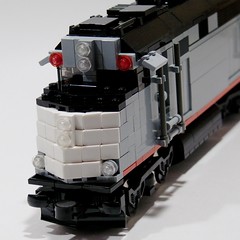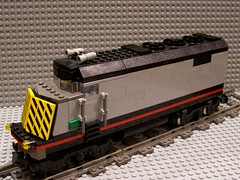This is my second attempt at modeling a Caltrain diesel locmotive, as seen running commuter trains between San José and San Francisco, CA. Years ago, I built a model of the Caltrain F40PH locomotive. The trickiest part of this engine to model is the nose, which has a “V” shape and also slopes back. In the earlier version, I mounted tiles at a complex compound angle, but was never entirely happy with that. The relatively new 1×1 “cheese” slope piece offers new opportunities for ways to achieve angles like this. But in order to get a smooth slope, I had to use half-plate offsets. I’m pretty happy with the result.
Years ago, I built a model of the Caltrain F40PH locomotive. The trickiest part of this engine to model is the nose, which has a “V” shape and also slopes back. In the earlier version, I mounted tiles at a complex compound angle, but was never entirely happy with that. The relatively new 1×1 “cheese” slope piece offers new opportunities for ways to achieve angles like this. But in order to get a smooth slope, I had to use half-plate offsets. I’m pretty happy with the result.
It is an EMD F40PH, similar to the ones Amtrak used to use for all their long haul trains, used by VIA Rail in Canada, and widely used in commuter lines around the USA and Canada.
This model made its debut at BrickFair, but I couldn’t post about it here since I only finished building it the night before I flew to DC for the convention. I also brought it to this past weekend’s BayLUG meeting in San Leandro.
Other notable features are the windscreens, which are made from 1×2 panels mounted on jumper plates and turned at a slight angle, half-plate inset panels on the sides, and another half-plate offset on the rear door. I’m planning to give a talk on half-plate offsets at BrickCon next month in Seattle. Like the previous version I used 4×4 old style turntables for the roof fans, but in this version there is a Technic gear representing the fan blades. I thought about motorizing them, but haven’t tried it yet.

